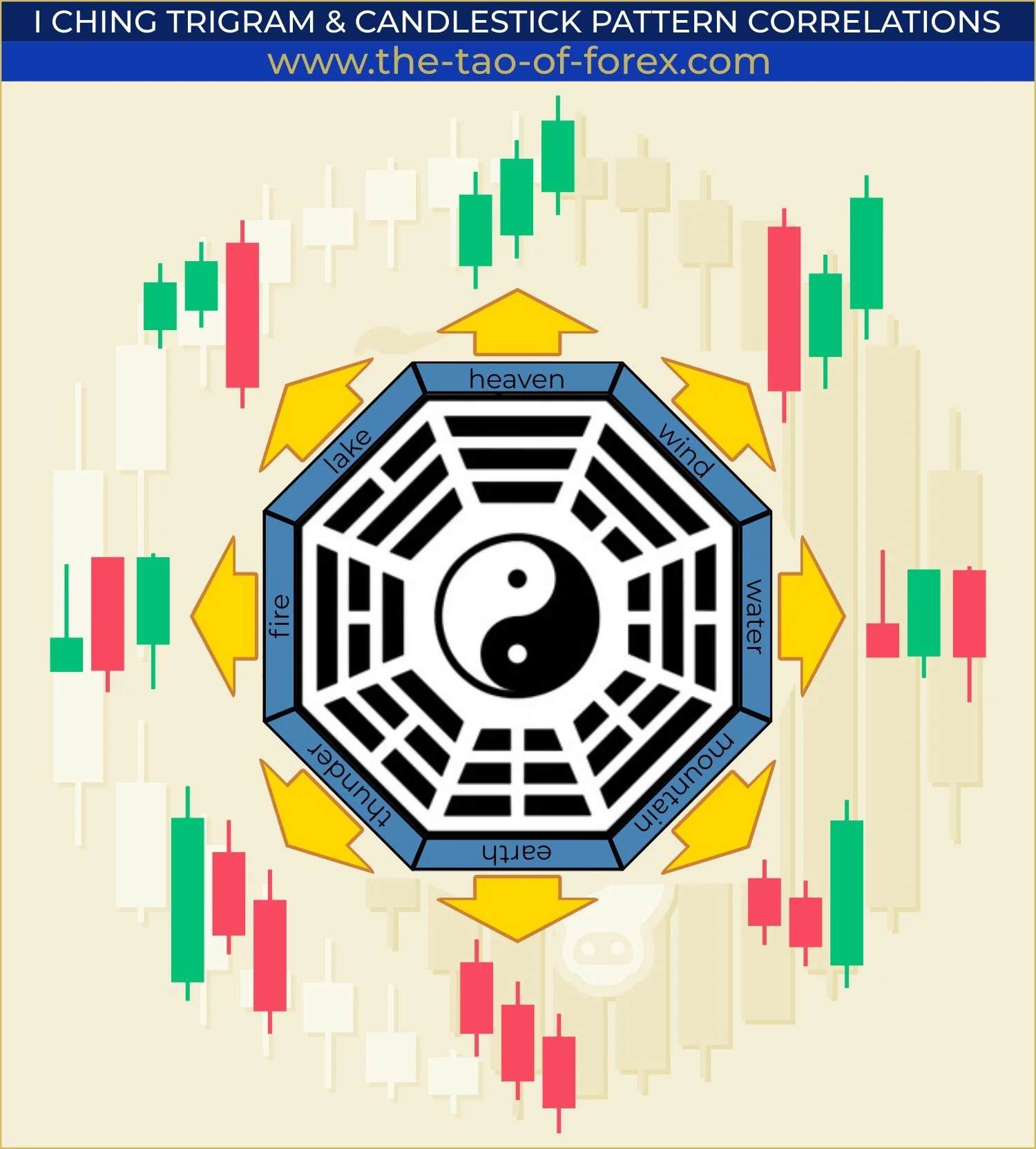THE TRIGRAMS
MARKET ARCHETYPES
Whether you’re a trader, investor, or just curious about Taoist philosophy, this episode will show you how the I Ching’s eight trigrams and 64 hexagrams mirror the rhythms of financial markets
The I Ching is one of the oldest books in human history, a Chinese classic blending philosophy, cosmology, and divination.
At its core, it teaches that life moves in cycles, governed by two forces: Yin (receptive, passive, dark) and Yang (active, creative, light).
Think of Yin and Yang like bear and bull markets—they’re opposites, but they need each other.
The I Ching maps these forces using 8 trigrams (3-line symbols) and 64 hexagrams (6-line symbols),
each representing a natural phenomenon—like Thunder, Water, or Mountain. In order to read them, imagine a chart’s candlesticks rotated horizontally; bullish lines become the solid lines(—) in a trigram, and bearish lines become broken lines(- -). Refer to the following diagram to observe how trigrams and candlestick patterns correlate.
THE EIGHT TRIGRAMS & MARKET PSYCHOLOGY
The eight trigrams aren’t just random symbols—they’re archetypes of energy. You could consider them as cosmic ‘personalities.’ And each one has a direct parallel in trading. Here are some examples of how you can interpret the line patterns:
1. ☰ (bullish-bullish-bullish) Heaven – Pure Yang
"Unstoppable momentum—like a bull market at its peak." Strong uptrend, pure yang energy. | Extreme bullishness—watch for exhaustion.
2. ☷ (bearish-bearish-bearish) Earth – Pure Yin
"Total receptivity—think accumulation phases, where smart money buys quietly." Strong downtrend, pure yin energy. | Extreme bearishness—watch for reversal.
3. ☳ (bullish-bearish-bearish) Thunder – Sudden movement
"Market shocks—earnings surprises, Fed announcements, flash crashes." Falling but finding support. | Early sign of bullish reversal.
4. ☴ (bearish-bullish-bullish) Wind – Slow but penetrating
"Trends that grind higher over time, like a steady uptrend in gold." Rising but losing strength. | Early warning of trend weakness.
5. ☵ (bearish-bullish-bearish) Water– Danger & uncertainty
"A market correction—where most traders panic, but opportunities hide." Bearish but with internal struggle. | Volatile downtrend—possible reversal.
6. ☲ (bullish-bearish-bullish) Fire – Bright but unstable
"Speculative manias—Bitcoin in 2021, meme stocks, bubbles." Bullish but with internal conflict. | Volatile uptrend—caution needed.
7. ☶ (bearish-bearish-bullish) Mountain – Resistance
"Strong support/resistance levels—where trends pause or reverse." Failed bullish attempt. | Strong rejection—possible short.
8. ☱ (bullish-bullish-bearish) Lake – Joy before the fall
"Market tops—when everyone’s euphoric, but smart traders exit." Failed bearish attempt. | Strong bounce—possible long.
See the pattern? The I Ching isn’t just about predicting—it’s about recognizing the energy of the moment.
Practical Use:
- Fire (⚊⚋⚊) & Water (⚋⚊⚋) indicate churning markets—hesitate before trading.
- Mountain (⚊⚋⚋) & Lake (⚋⚊⚊) suggest failed moves—fade the breakout.
Each trigram is a lens. For example, if ‘Thunder’ (volatility) meets ‘Mountain’ (resistance), you might expect a rejection. This isn’t magic—it’s pattern recognition with a Taoist twist.
HEXAGRAMS – THE 64 MARKET SCENARIOS
Now, when you stack two trigrams, you get a hexagram—64 in total. Each is like a market scenario.
(Visual: Show Hexagram 12, "Standstill" – Heaven over Earth.)
Example: Hexagram 12 – "Standstill" (Pǐ)
"Heaven above, Earth below—they’re not interacting. The market’s stuck."
"This could mean a range-bound market—no trend, low volume. Time to wait."
(Visual: Show Hexagram 29 – "Water over Water" – Double Danger.)
Example: Hexagram 29 – "The Abysmal" (Kǎn)
"Double Water—extreme risk. Think 2008 crash, or March 2020."
"But the I Ching says: ‘If you’re cautious, you’ll survive.’ A lesson for traders!"
So how can you apply this? You don’t need to throw your TA away—just layer this mindset on top.
1. Recognize the Phase
Is the market in Fire (mania) or Water (fear)? Adjust your strategy.
2. Respect Cycles
Markets move in Yin-Yang loops—don’t fight the trend.
3. Use Hexagrams as a Filter
If your chart says ‘buy’ but the energy is Mountain (resistance), be cautious.
The I Ching doesn’t give price targets—it gives wisdom. And in trading, that’s the edge.
